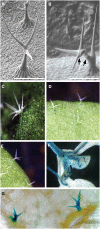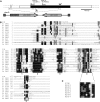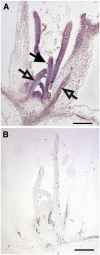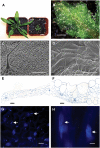SIAMESE, a plant-specific cell cycle regulator, controls endoreplication onset in Arabidopsis thaliana
- PMID: 17098811
- PMCID: PMC1693949
- DOI: 10.1105/tpc.106.044834
SIAMESE, a plant-specific cell cycle regulator, controls endoreplication onset in Arabidopsis thaliana
Abstract
Recessive mutations in the SIAMESE (SIM) gene of Arabidopsis thaliana result in multicellular trichomes harboring individual nuclei with a low ploidy level, a phenotype strikingly different from that of wild-type trichomes, which are single cells with a nuclear DNA content of approximately 16C to 32C. These observations suggested that SIM is required to suppress mitosis as part of the switch to endoreplication in trichomes. Here, we demonstrate that SIM encodes a nuclear-localized 14-kD protein containing a cyclin binding motif and a motif found in ICK/KRP (for Interactors of Cdc2 kinase/Kip-related protein) cell cycle inhibitor proteins. Accordingly, SIM was found to associate with D-type cyclins and CDKA;1. Homologs of SIM were detected in other dicots and in monocots but not in mammals or fungi. SIM proteins are expressed throughout the shoot apical meristem, in leaf primordia, and in the elongation zone of the root and are localized to the nucleus. Plants overexpressing SIM are slow-growing and have narrow leaves and enlarged epidermal cells with an increased DNA content resulting from additional endocycles. We hypothesize that SIM encodes a plant-specific CDK inhibitor with a key function in the mitosis-to-endoreplication transition.
Figures







Similar articles
-
SIAMESE cooperates with the CDH1-like protein CCS52A1 to establish endoreplication in Arabidopsis thaliana trichomes.Genetics. 2010 May;185(1):257-68. doi: 10.1534/genetics.109.113274. Epub 2010 Mar 1. Genetics. 2010. PMID: 20194967 Free PMC article.
-
The CDK Inhibitor SIAMESE Targets Both CDKA;1 and CDKB1 Complexes to Establish Endoreplication in Trichomes.Plant Physiol. 2020 Sep;184(1):165-175. doi: 10.1104/pp.20.00271. Epub 2020 Jul 21. Plant Physiol. 2020. PMID: 32694133 Free PMC article.
-
Functional Analysis of Short Linear Motifs in the Plant Cyclin-Dependent Kinase Inhibitor SIAMESE.Plant Physiol. 2018 Aug;177(4):1569-1579. doi: 10.1104/pp.18.00147. Epub 2018 Jun 14. Plant Physiol. 2018. PMID: 29903833 Free PMC article.
-
Switching the cell cycle. Kip-related proteins in plant cell cycle control.Plant Physiol. 2005 Nov;139(3):1099-106. doi: 10.1104/pp.105.069906. Plant Physiol. 2005. PMID: 16286449 Free PMC article. Review. No abstract available.
-
Plant Cyclin-Dependent Kinase Inhibitors of the KRP Family: Potent Inhibitors of Root-Knot Nematode Feeding Sites in Plant Roots.Front Plant Sci. 2017 Sep 8;8:1514. doi: 10.3389/fpls.2017.01514. eCollection 2017. Front Plant Sci. 2017. PMID: 28943880 Free PMC article. Review.
Cited by
-
Genome-wide evolutionary characterization and expression analysis of SIAMESE-RELATED family genes in maize.BMC Evol Biol. 2020 Jul 29;20(1):91. doi: 10.1186/s12862-020-01619-2. BMC Evol Biol. 2020. PMID: 32727363 Free PMC article.
-
A proposed conserved role for an avocado FW2.2-like gene as a negative regulator of fruit cell division.Planta. 2010 Aug;232(3):663-76. doi: 10.1007/s00425-010-1200-3. Epub 2010 Jun 12. Planta. 2010. PMID: 20544218
-
Analyses of phylogeny, evolution, conserved sequences and genome-wide expression of the ICK/KRP family of plant CDK inhibitors.Ann Bot. 2011 May;107(7):1141-57. doi: 10.1093/aob/mcr034. Epub 2011 Mar 7. Ann Bot. 2011. PMID: 21385782 Free PMC article.
-
BRANCHLESS TRICHOMES links cell shape and cell cycle control in Arabidopsis trichomes.Development. 2011 Jun;138(11):2379-88. doi: 10.1242/dev.058982. Development. 2011. PMID: 21558384 Free PMC article.
-
Evolution of networks and sequences in eukaryotic cell cycle control.Philos Trans R Soc Lond B Biol Sci. 2011 Dec 27;366(1584):3532-44. doi: 10.1098/rstb.2011.0078. Philos Trans R Soc Lond B Biol Sci. 2011. PMID: 22084380 Free PMC article. Review.
References
-
- Alvarez, J., Guli, C.L., Yu, X.H., and Smyth, D.R. (1992). Terminal Flower: A gene affecting inflorescence development in Arabidopsis thaliana. Plant J. 2 103–116.
-
- An Colo An-Carmona, A., You, R., Haimovitch-Gal, Y., and Doerner, P. (1999). Spatio-temporal analysis of mitotic activity with a labile cyclin:GUS fusion protein. Plant J. 20 503–508. - PubMed
-
- Barlow, P. (1978). Endopolyploidy: Towards an understanding of its biological significance. Acta Biotheor. 27 1–18.
Publication types
MeSH terms
Substances
Associated data
- Actions
- Actions
- Actions
- Actions
- Actions
- Actions
- Actions
- Actions
- Actions
- Actions
- Actions
- Actions
Grants and funding
LinkOut - more resources
Full Text Sources
Other Literature Sources
Molecular Biology Databases
Miscellaneous

